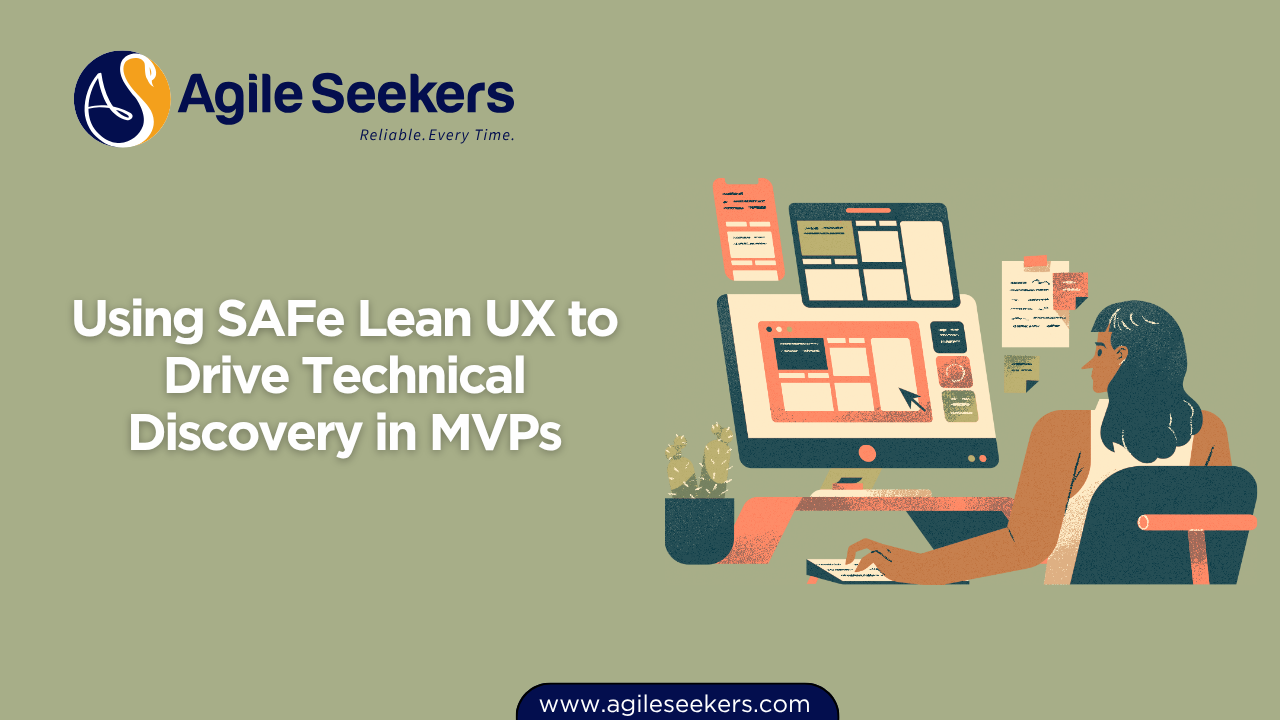Using SAFe Lean UX to Drive Technical Discovery in MVPs

Lean UX in the Scaled Agile Framework (SAFe) is a practical approach that bridges customer-centric design with iterative product development. When applied to MVP (Minimum Viable Product) initiatives, Lean UX drives early validation, reduces waste, and helps teams make sound technical decisions through discovery rather than assumption. For enterprises building complex systems, technical feasibility often carries the same weight as user desirability. SAFe Lean UX provides a structured way to explore both.
Understanding Lean UX in the SAFe Context
Lean UX in SAFe focuses on hypotheses, collaborative design, and real-time user feedback. Instead of relying on lengthy requirement documents or upfront specs, teams form lightweight hypotheses to test ideas quickly and gain customer insight. This methodology works in short feedback loops and is especially useful during MVP development.
SAFe recognizes Lean UX as a key component of continuous exploration in the Continuous Delivery Pipeline. It encourages cross-functional teams—including system architects, developers, product managers, and designers—to explore both customer problems and technical risks before committing to full-scale implementation.
For those new to SAFe Lean UX, the Scaled Agile Framework's guidance offers a solid foundation.
Role of Lean UX in Technical Discovery
Technical discovery isn't limited to backend feasibility. It includes decisions about performance constraints, integration feasibility, security posture, and scalability. Here's how Lean UX contributes:
-
Hypothesis-driven development: Teams begin by framing assumptions about user needs and technical unknowns. Example: "We believe integrating with the legacy payment system in under 2 seconds is possible. We'll know we're right when users complete payment within that time."
-
Exploratory Enablers: Enablers allow exploration of technical risks during MVP development. These may include spike stories, architectural runway setup, or tech stack validation.
-
Collaborative Design Workshops: Engineers, architects, and UX designers co-create experiments. These sessions reveal early constraints and help align MVP goals with what’s technically achievable.
-
Fast Feedback on Technical Prototypes: Instead of building production-ready code, teams build throwaway prototypes to validate technical paths. Feedback is gathered not just from users but from architects, DevOps, and security stakeholders.
-
Incremental MVP Delivery: Each MVP iteration introduces a small but valuable capability. Technical hypotheses are validated in parallel with usability feedback.
Structuring MVPs for Technical Learning
When MVPs aim for discovery, structuring them to test both desirability and feasibility is key. SAFe Lean UX encourages teams to:
-
Define MVP success criteria upfront, including user and system-level outcomes.
-
Identify risky technical assumptions early and prioritize them.
-
Use Innovation and Planning (IP) Iterations for technical spikes that inform MVP design.
-
Maintain traceability between MVP features and architectural enablers.
For those exploring SAFe roles that govern such initiatives, a good starting point is the SAFe POPM Certification, which covers Lean UX integration in MVPs.
Real-World Use Case: Fintech MVP with API Integration
A fintech company building an MVP for real-time balance aggregation used Lean UX to validate both customer value and technical integration capabilities. The team:
-
Formulated a hypothesis: "If we can aggregate balances from 3 major banks via open APIs in under 3 seconds, users will proceed to link their accounts."
-
Identified a technical enabler for API response time benchmarking.
-
Ran a lightweight integration with mocked bank APIs.
-
Validated latency issues and scaled back the MVP scope to ensure reliability.
This approach helped avoid full-scale integration investment before knowing the limits of their infrastructure.
The Role of Product Management in Lean UX Technical Discovery
Product Owners and Product Managers play a central role in aligning Lean UX discovery with technical priorities. By facilitating collaboration between stakeholders and shaping hypotheses that span both customer value and technical risk, they act as the connective tissue of Lean MVP development.
A formal SAFE Product Owner Certification trains individuals on how to manage these dual aspects in an Agile Release Train (ART).
Common Pitfalls to Avoid
-
Focusing solely on UI/UX: Lean UX is often misunderstood as being limited to visuals. It’s about validating business and technical assumptions, not just designing screens.
-
Skipping technical stakeholders in discovery: Leave out DevOps, architects, or cybersecurity and you risk building something infeasible.
-
Building MVPs as mini-products: Overengineering defeats the purpose of MVPs. Keep the scope narrow and learning-focused.
Integrating Lean UX with SAFe POPM Training
Lean UX principles are part of the SAFe POPM curriculum, especially around Program Increment (PI) Planning, where MVP features, enablers, and discovery tasks are aligned. SAFe Popm training gives professionals the toolkit to lead these efforts effectively.
External References for Broader Insight
-
Learn how Spotify’s squads and tribes use Lean UX thinking for discovery: Spotify Engineering Culture
-
The book "Lean UX" by Jeff Gothelf remains a foundational resource for understanding the mindset behind hypothesis-driven design.
-
Insights from ThoughtWorks Technology Radar offer evolving patterns in technical validation and MVP experimentation.
Conclusion
Using SAFe Lean UX to drive technical discovery during MVP development helps organizations de-risk early decisions, avoid wasteful builds, and uncover constraints before scaling. With strong involvement from cross-functional teams and a discovery-driven mindset, Lean UX shifts MVPs from assumption-driven to evidence-driven.
To lead or contribute meaningfully in such initiatives, consider exploring SAFE Product owner/Manager certification and strengthen your role in delivering technically sound, user-centric solutions.
Also read - Handling Architectural Dependencies Across Agile Release Trains (ARTs)




















